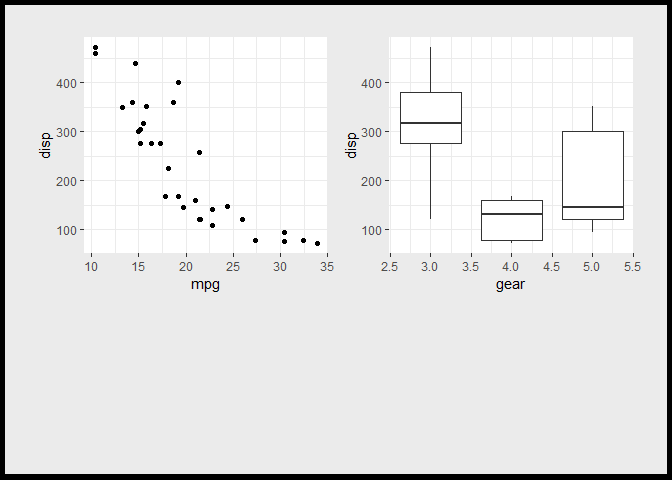patchwork 
The goal of patchwork is to make it ridiculously simple to combine
separate ggplots into the same graphic. As such it tries to solve the
same problem as gridExtra::grid.arrange() and cowplot::plot_grid but
using an API that incites exploration and iteration.
Installation
You can install patchwork from github with:
# install.packages("devtools")
devtools::install_github("thomasp85/patchwork")Basic example
The usage of patchwork is simple: just add plots together!
library(ggplot2)
library(patchwork)
p1 <- ggplot(mtcars) + geom_point(aes(mpg, disp))
p2 <- ggplot(mtcars) + geom_boxplot(aes(gear, disp, group = gear))
p1 + p2You are of course free to also add the plots together as part of the same plotting operation:
ggplot(mtcars) +
geom_point(aes(mpg, disp)) +
ggplot(mtcars) +
geom_boxplot(aes(gear, disp, group = gear))Layout and nesting
Layouts can be specified by adding a plot_layout() call to the
assemble. This lets you define the dimensions of the grid and how much
space to allocate to the different rows and columns.
p1 + p2 + plot_layout(ncol = 1, heights = c(3, 1))If you need to add a bit of space between your plots you can use
plot_spacer() to fill a cell in the grid with nothing.
p1 + plot_spacer() + p2You can make nested plots layout by wrapping part of the plots in parentheses. In this case the layout is scoped to the different nesting levels.
p3 <- ggplot(mtcars) + geom_smooth(aes(disp, qsec))
p4 <- ggplot(mtcars) + geom_bar(aes(carb))
p4 + {
p1 + {
p2 +
p3 +
plot_layout(ncol = 1)
}
} +
plot_layout(ncol = 1)Annotating Plots
In many cases, one doesn’t want to just assemble plots together, but
also label them or annotate them enabling one to easily refer to
each piece, as well as adding titles to the whole. Enter the
plot_annotation function
p1 + p2 + plot_annotation(title = "A great plot!", tag_levels = "A")Advanced features
In addition to adding plots and layouts together, patchwork defines
some other operators that might be of interest. - behaves like + but
puts the left and right side in the same nesting level (as opposed to
putting the right side into the left side’s nesting level). Observe:
p1 + p2 + p3 + plot_layout(ncol = 1)This is basically the same as without braces (just like standard math arithmetic) - the plots are added sequentially to the same nesting level. Now consider:
p1 + p2 - p3 + plot_layout(ncol = 1)Now p1 + p2 and p3 are on the same level…
A note on semantics. If
-is read as minus its use makes little sense as we are not removing plots. Think of it as a hyphen instead…
Often you are interested in just putting plots besides or on top of each
other. patchwork provides both | and / for horizontal and vertical
layouts respectively. They can, of course, be combined for a very
readable layout syntax:
(p1 | p2 | p3) /
p4There are two additional operators that are used for a slightly
different purpose, namely to reduce code repetition. Consider the case
where you want to change the theme for all plots in an assembly. Instead
of modifying all plots individually you can use & or * to add
elements to all subplots. The two differ in that * will only affect
the plots on the current nesting level:
(p1 + (p2 + p3) + p4 + plot_layout(ncol = 1)) * theme_bw()whereas & will recurse into nested levels:
p1 + (p2 + p3) + p4 + plot_layout(ncol = 1) & theme_bw()Note that parentheses are required in the former case due to the higher precedence of the
*operator. The latter case is the most common so it deserves the easiest use.
Global theme options
You can also adjust the aesthetics of the overall image via the
plot_theme() function.
Modify the background color:
borderless_theme <- theme_bw() + theme(panel.border = element_blank())
p1 <- ggplot(mtcars) + geom_point(aes(mpg, disp)) + borderless_theme
p2 <- ggplot(mtcars) + geom_boxplot(aes(gear, disp, group = gear)) + borderless_theme
p1 + p2 + plot_theme(background = "gray92")You can also add a border around the image and padding to each side:
p1 + p2 + plot_theme(
background = "gray92",
border_color = "black",
border_thickness = 10,
padding = unit(c(1, 1, 5, 1), "cm"))This is all patchwork does for now, but stay tuned as more
functionality is added, such as collapsing guides, etc…
Note that parentheses are required in the former case due to the higher precedence of the
*operator. The latter case is the most common so it deserves the easiest use.











